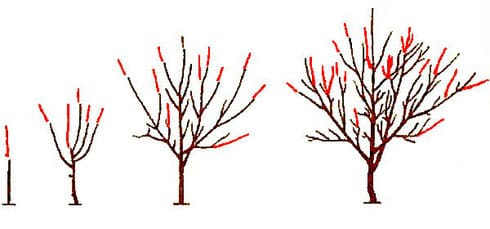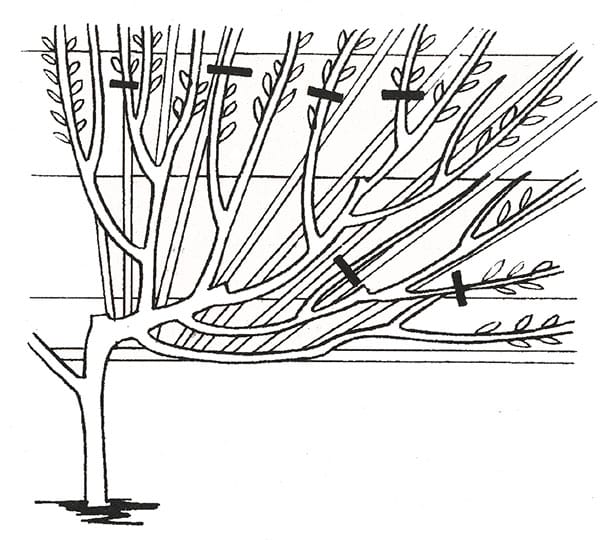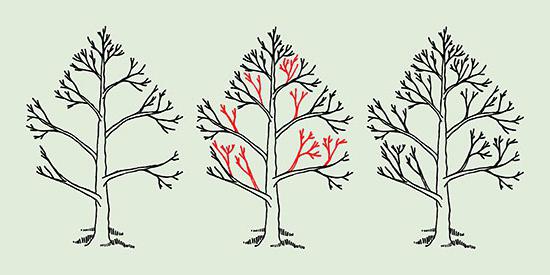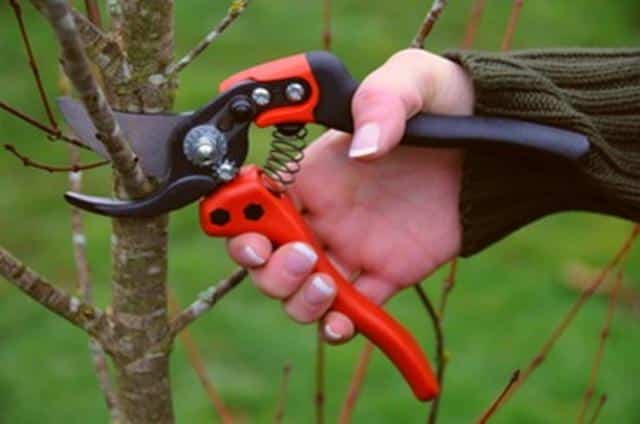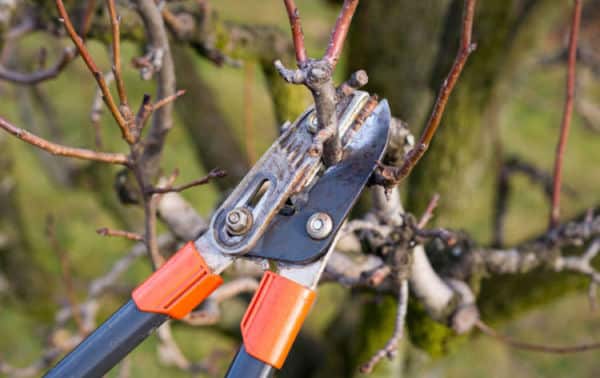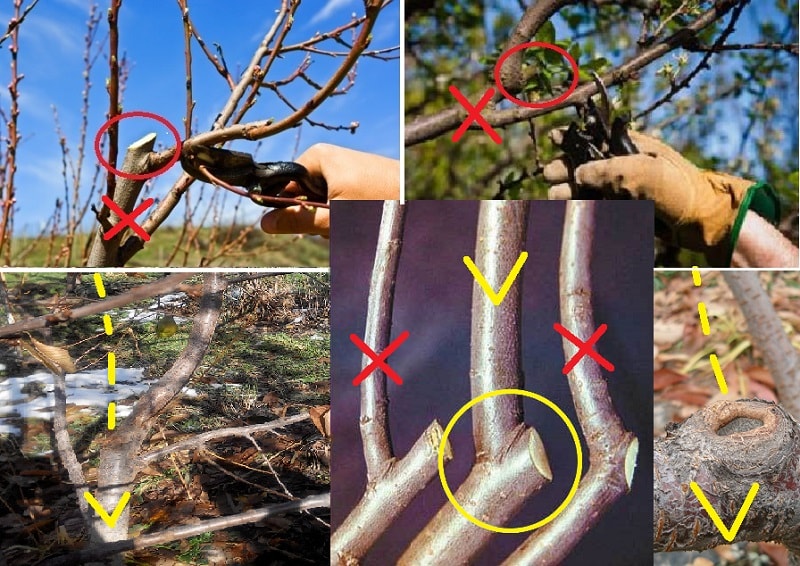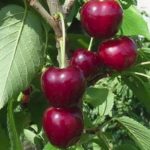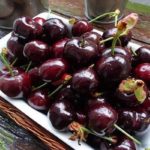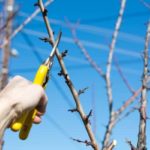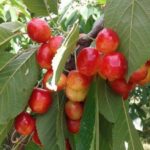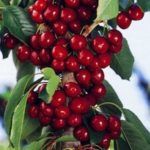Proper and timely garden care is necessary to obtain a high yield. All gardeners know that cherries, pruned to ensure their constant growth and proper crown formation, can become a decoration for any summer cottage. Knowing the basic rules of pruning and the requirements for this process, the gardener will achieve a stable harvest and normal development of the tree.
Advantages and disadvantages of the procedure
By pruning a tree, several goals are achieved simultaneously:
- the crown is thinned out - excess branches growing inside the trunk are removed, which leads to an increase in air access. This is a necessary preventive measure against the development of fungal diseases;
- In order for there to be a good harvest, the branches of old trees are rejuvenated, which serves to improve development and increase fruiting;
- dry and diseased shoots are removed;
- the overall growth of cherries decreases, making it more convenient to harvest;
- the taste of berries improves;
- the tree's resistance to frost increases during the winter season.
But if pruning is done incorrectly and at the wrong time, it will harm the tree and cause the development of diseases, resulting in a drop in yield.
Optimal timing
Gardeners disagree on the correct timing for pruning. Some believe that it should be held in the spring, others - in the fall. But, according to qualified specialists, pruning should be done at least three times a year.
Spring
There are two opinions about the time to start spring pruning: in early spring, before the sap begins to flow, or later, when the tree has already woken up after winter - both options are suitable. In the first case, it is easier to consider the features of crown formation; in the second, the wound healing process improves. This allows you to painlessly thin out skeletal branches and remove the top.
But the main condition in determining the timing is to wait until a stable above-zero temperature is established, when night frosts definitely do not occur. The exact timing depends on the climatic conditions of the region.In the north of Russia, the procedure is performed in early April, in the south - at the end of winter, in temperate latitudes - closer to mid-March.
Summer
In summer, cherries are pruned twice:
- the first time - in early June, after the formation of the ovary. The ends of this year's shoots are removed, which stimulates the growth of lateral shoots;
- the second - in July, when the harvest has already been harvested. If it has been a long spring or the tree is a late-ripening species, pruning is carried out in August. During this period, excess branches are removed, and the shoots that grew back after the first treatment are shortened by ten centimeters.
This choice of timing allows the tree, even in the short summer of the northern regions, to recover and stock up on nutrients.
To increase productivity, the following methods are used:
- remove shoots directed parallel to the trunk. The most fruit-bearing branches are located horizontally; after the procedure, the supply of nutrients to them increases;
- bending branches with ropes. This method reduces the need for trimming and sets the desired direction for the skeletons. The ropes are secured with pegs, and after some time, when the crown takes the desired shape, they are removed.
By combining these methods, you can achieve a significant increase in yield.
Autumn
Most gardeners know that after fruiting and harvesting, as well as subsequent pruning in the summer, the need for this procedure arises in the fall.
This is due to the need to achieve the following tasks:
- thin out the crown, remove damaged and diseased branches growing at the wrong angle;
- shorten shoots by a third.
The procedure begins after the leaves have fallen to allow a detailed view of the tree.The completion date depends on the region, but pruning should be completed much earlier than the onset of cold weather so that the damaged areas have time to heal, since at cold temperatures this process proceeds much more slowly.
The need for winter pruning
Winter pruning is carried out on old trees in order to rejuvenate the crown. The work is carried out towards the end of winter, in the most favorable and warm weather. This treatment not only removes old branches, the procedure is necessary so that the cherry tree is not tall. The branches growing upward are removed, which makes access easier when picking berries.
Main types of cherry pruning
Depending on the purpose, the following types of pruning are distinguished:
- formative - produced for young trees in the spring season;
- sanitary – most often performed in the fall. Infected and damaged branches are removed, followed by immediate burning, to prevent the development of the disease. In the spring, shoots damaged by frost are removed for this purpose;
- rejuvenating – carried out in autumn or winter. Allows you to remove old branches that cease to bear fruit, at the same time the tree is thinned out, damaged shoots are cut off;
- during fruiting - branches that have broken off from the load of ripening fruits are removed in case of an excessively abundant harvest.
The cherry crown is formed in several ways:
- Australian bush - from the very beginning of the seedling's development, excessive tree height is excluded. When the seedling is planted, the total length of the trunk is left no more than half a meter. Four lateral branches are left; Use clothespins to set the direction parallel to the ground. The next year, the crown is given the shape of a vase - shoots directed inward are removed;
- Spanish bush - the name comes from the country where this method began to be used.Suitable for regions with warm climates, where it is possible to prevent kidney damage in the event of recurrent frost. The planted tree is pruned to seventy centimeters, leaving four main branches. Then, in the fall, guys set the greatest opening angle, and each season the growing shoots are successively shortened with regular thinning;
- KGB method - the abbreviation comes not from the government structure of the same name, but from the name of the Australian gardener who proposed this method of crown formation. The initial height of the seedling is left about half a meter, with a vigorous rootstock - a little higher. On the remaining four, strongest branches, as they grow, two shoots are left; then successively increase the total number to twenty. Periodically, the branches are renewed and thinned out, maintaining a stable number of shoots.
The choice of crown formation method depends on the preference of the gardener and the climatic characteristics of the region.
Tool preparation
Trimming is done using the following tool:
- garden shears - they are used to remove non-woody young shoots;
- pruning shears - for thin branches;
- lopper - remove branches located in places with inconvenient access;
- garden saw - to remove thick and dried branches;
- garden knife - trim small shoots, also used in case of grafting.
The tool must be pre-prepared and sharpened. The saw teeth must be properly set so that the blade does not pinch when cutting.
Access to the tree along its entire height will be provided by a stepladder. The choice of ladder size depends on the height of the tree.
Step-by-step pruning instructions
Pruning cherries according to the system involves performing the correct formation of the crown, with a reduction in the permissible height of the tree:
- skeletal branches (about four) directed in opposite directions are determined, the rest are removed;
- the formation of the next tiers is carried out in a similar way;
- the desired height is marked on the trunk, all branches exceeding the required level are pruned.
At the next stage, they begin to regulate the height of the main trunk:
- when the central trunk approaches the height of the branches of the third tier, it is sawed off;
- after several new leading shoots appear, they are grown to thirty centimeters and cut off.
This procedure will allow the tree to direct maximum energy towards fruiting. All subsequent central shoots will not tend upward too much, which will make it possible in the future, by adjusting the length of the lateral branches, to ensure the established height of the tree.
Nuances when holding an event
When pruning cherries, it is important to try to cause as little damage to the tree as possible. If a shoot is cut near the trunk, you should not touch the bark near the pocket - the size of the wound will be too large. At the same time, you must try not to retreat too far from the base, so as not to leave a large knot. Thick branches are first sawed down at the bottom - given the fragile nature of the cherry, there is a danger of involuntary breakage with peeling of the bark.
Formation of young seedlings
When forming a young seedling, it is important to correctly calculate the height of the trunk. This is determined by region:
- seventy centimeters of height of the central trunk - for the southern ones;
- up to sixty - in the Middle Zone;
- about forty - in the northern ones.
If the one-year-old seedling does not reach the specified height, the event is postponed to a future period. In the first year of growth, the tree should reach two meters.
In the second year, the lower tier is formed according to the method described above. On the third day, all the main processes are aligned at the level of the weakest skeletal branch, and the crown is thinned out by removing the processes directed inward.
The fourth year is the final year for crown formation. The second and third tier are shortened to eighty centimeters, the first - to half a meter. If the shoots cross, the one directed in the most inconvenient direction is removed.
A tree older than five years only needs sanitary treatment and crown thinning.
Pruning old cherries
With age, the intensity of cherry fruiting fades, so it is important to carry out anti-aging pruning. In trees older than three years, the branches are shortened with the removal of shoots. At the same time, damaged and drying shoots are removed. As a result, young shoots appear, and the tree gains a second youth.
Tree care after pruning
When performing pruning, it is very important to disinfect the cuts and cuts. For this, a solution of copper sulfate and garden pitch are used. Wounds are treated immediately after surgery. It is also necessary to pre-disinfect the instrument. Having mastered the correct pruning techniques, the gardener will be able to achieve a high, stable yield and properly shape the tree.

